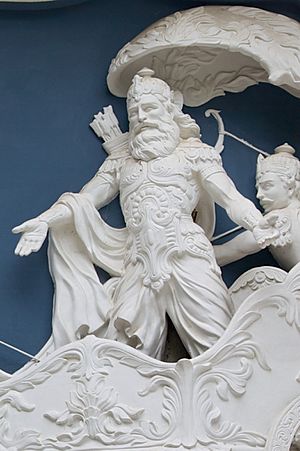Kshatriya facts for kids
The Kshatriya (pronounced KSHAH-tree-yah) is one of the four main social groups in ancient Hindu society. The word comes from Sanskrit and means "rule" or "authority." Kshatriyas were traditionally known as warriors, rulers, and protectors of society. They were like the kings, princes, and soldiers of ancient India.
Contents
History of the Kshatriyas
Early Vedic Times
In the very early days of ancient India, during the Vedic period, tribes were often led by a king called a Rajan. This king might have been chosen by the tribe's people. His main job was to protect the tribe and their animals. There wasn't a clear system of four social groups yet.
Later Vedic Period
Later on, a famous hymn called the Purusha Sukta from the Rigveda described how four social groups were created. These groups were the brahmin (priests), Kshatriya (warriors/rulers), vaishya (farmers/merchants), and shudra (workers).
At first, the term rajanya was used. This word meant "kinsmen of the ruler." It showed that these people were related to the king. Over time, the word Kshatriya became more common. Kshatriya meant someone who had power over a specific area or land. This was different from just being related to the king.
The idea of a Kshatriya having power over land eventually led to the concept of kingship. They were seen as the ones who could claim control over territories.
Changes in Social Order
Around 800 to 700 BCE, the order of these social groups sometimes changed. But by about 450 to 100 BCE, the order became fixed: Brahmana, Kshatriya, Vaishya, and Shudra.
Kshatriyas were often seen as very important. Sometimes, they even questioned the religious practices of the priests. This led to new ideas found in texts called the Upanishads.
Mahajanapadas Period
From about 600 to 300 BCE, during the time of the Mahajanapadas (large kingdoms), some areas were ruled by groups of Kshatriya clans. These were like small republics where the Kshatriyas served as representatives and discussed important matters. Many of these Kshatriyas supported new religions like Buddhism and Jainism.
In other kingdoms, kings claimed to be Kshatriyas to show their right to rule. However, not all kings actually came from Kshatriya families. After the Maurya Empire fell, many new rulers in northern India were not Kshatriyas.
New Kshatriya Dynasties
From 300 to 700 CE, many new royal families appeared. Priests helped these new rulers by connecting them to the famous Kshatriya families from old stories and epics, like the Solar and Lunar dynasties. This made the new rulers seem more legitimate. In return, these new Kshatriya rulers would support and reward the priests. This helped shape the idea of what a Kshatriya ruler should be like for many years to come.
Kshatriyas Today
Even in modern times, some groups of people claim to have Kshatriya origins. Traditionally, their role was to lead and protect their villages. They would also manage lands they had conquered.
Symbols of Kshatriyas
In some old rituals, the nyagrodha (banyan tree) staff was given to the Kshatriya class. This was meant to give them strength and energy.
Kshatriya Family Lines
Ancient texts like the Vedas don't mention specific Kshatriya family lines. However, later stories and epics describe two main lineages:
- The Solar dynasty (Suryavamsha), who were said to be descended from the Sun god.
- The Lunar dynasty (Chandravamsha/Somavamsha), who were said to be descended from the Moon god.
There are also other family lines, like the Agnivanshi (fire lineage), who claimed to come from the god of fire, Agni. Some claimed descent from the Nagas (snake-born beings) found in stories like the Mahabharata.
See also
 In Spanish: Kshatriya para niños
In Spanish: Kshatriya para niños
- Indian caste system
- Forward castes
- Sanskritisation


